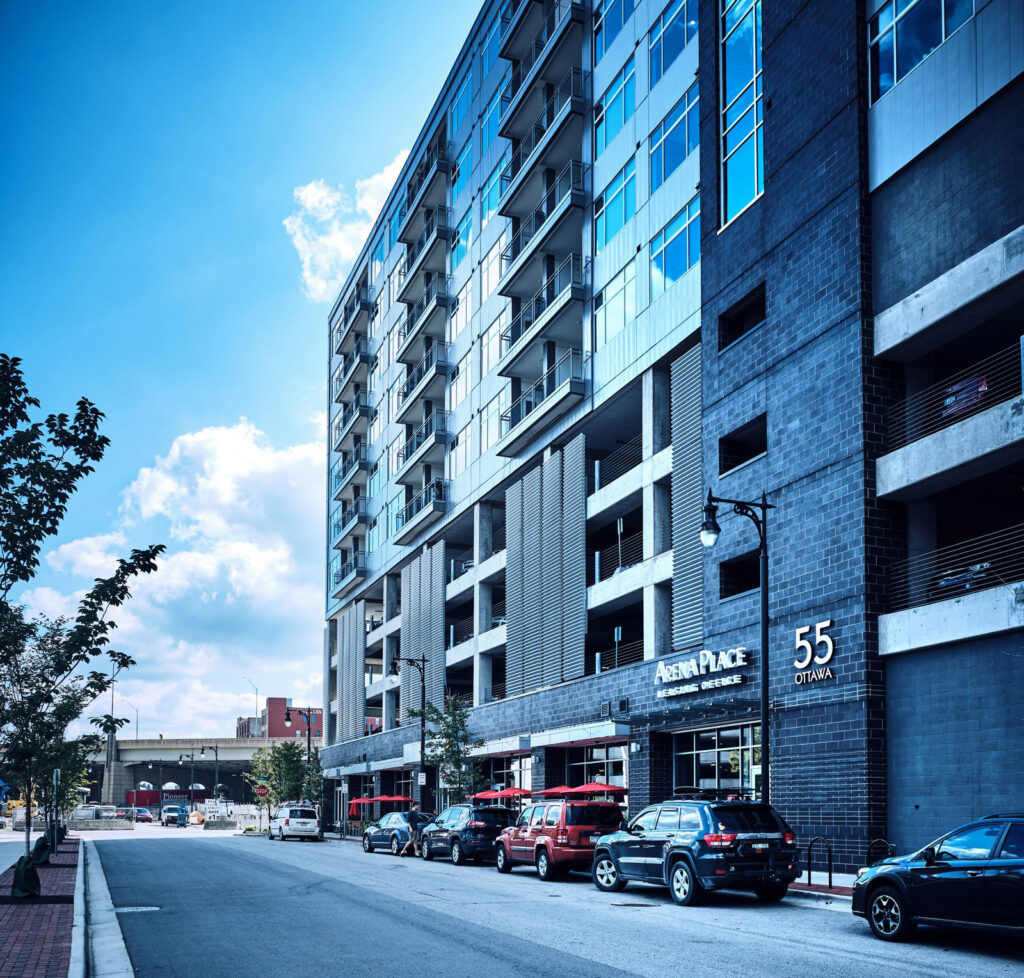Overview
Downtown Grand Rapids is experiencing a resurgence in activity, maintaining its status as a popular nightlife destination, alongside a slow and steady return to physical office spaces. This activity is not only expected to stay, but continue growing as exciting new developments look to push the city forward, including the amphitheater, Amway Stadium, and the excitement surrounding a proposed new aquarium.
These developments promise to increase downtown traffic, making parking availability a critical point of discussion. For commercial real estate stakeholders, understanding the evolving parking landscape is essential to supporting the city’s growth, ensuring a hassle-free downtown experience.
The city relies on the quality and convenience of its parking, and the downtown parking landscape would not be where it is today without Ellis Parking.
Recent Developments
Mike Ellis, CEO of Ellis Parking Company, shared his insights on the current situation with parking in downtown Grand Rapids, and what to expect as new developments move forward.
There’s a noticeable shift back toward pre-pandemic activity levels in Grand Rapids, as businesses slowly start to reenter physical office spaces, increasing activity in certain areas. Ellis Parking noted that 85% of the workforce is back but only 75% of the time. With only 60.8% of workers being fully on-site nationally, Grand Rapids appears to be ahead of the curve. However, that the type of activity has changed, specifically on the retail front.

Recent trends highlight the importance of ensuring convenient parking options in downtown areas without requiring customers to pay excessive meter fees. In response, the City of Grand Rapids has announced a change in parking meter enforcement hours, extending them until 7:00 PM. This adjustment is expected to positively impact the downtown dining experience by encouraging a more even distribution of visitors during peak hours. By extending enforcement later into the evening, the policy aims to stagger the dinner rush, reducing congestion and making it easier for customers to find available street parking. This will benefit both restaurants and local businesses by promoting a smoother flow of visitors and enhancing accessibility to downtown restaurants.

“The city is trying to encourage additional activity with new developments – come early for dinner, stay late for a drink, whatever it might be.”
– Mike Ellis | CEO of Ellis Parking
These changes aim to foster a more vibrant downtown, encouraging visitors to spend more time in the city without the stress of rushing for parking or the frustration of searching for a spot. However, planned developments south of Fulton, including the new amphitheater, have raised concerns among businesses. With only a 340-space parking ramp proposed, some worry that these additions, without further measures to expand parking availability, could lead to increased congestion in the downtown area.
While parking challenges accompany growth, new developments like the amphitheater and Amway Stadium are pivotal in driving economic growth, attracting visitors, and fostering a thriving downtown. These changes present an opportunity for the city to adopt creative solution such as multi-use parking structures, improved public transit options, and pedestrian-friendly initiatives that not only address parking concerns but also ensure the continued development of a dynamic, accessible, and forward-thinking urban core.
Looking Ahead
Effectively managing these opportunities requires a clear understanding of how visitors interact with parking. Leveraging existing resources can help to reduce frustration and improve access. Ellis Parking highlighted how typical downtown visitors often interact with parking — driving directly to their destination before beginning their search for a spot. This approach can lead to congestion and frustration, as drivers may overlook convenient parking options just a short walk away.
Facilities like the Ottawa & Fulton Ramp, Studio Park(ing), Cherry & Commerce Ramp, 231 Fulton Street W Parking, and the Fulton & Market Lot all offer accessible solutions within a half-mile of the future amphitheater. According to Ellis Parking, the decision not to build additional parking near the venue reflects the existing market conditions and demand, suggesting that current parking resources can meet the anticipated need if utilized effectively.

“You can’t have vibrant developments that drive density and expect everything to run smoothly. Increased delays when getting in and out of downtown are inevitable.”
– Mike Ellis | CEO of Ellis Parking
To improve the visitor experience, increasing awareness of these nearby options is essential. Leveraging tools such as digital parking guides and interactive maps can help direct drivers to available spaces, reducing congestion and making parking more efficient, even if spaces are slightly farther from their destination. Grand Rapids is poised for significant growth with new developments like the amphitheater, Amway Stadium, and proposed aquarium set to enhance the city’s vibrancy. Addressing parking challenges will be essential to ensuring accessibility, supporting downtown businesses, and reducing congestion.
Moving Forward
By embracing innovative solutions and collaborating with Ellis Parking, the city can build a thriving, dynamic urban core that benefits residents, businesses, and visitors alike. With thoughtful planning and ongoing investment in infrastructure, Grand Rapids will continue to evolve into a more developed and accessible city.


